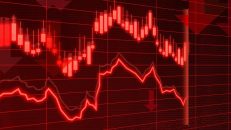
Technical analysis enables you to identify trends and patterns within charts to make predictions about future price movements.
But were you able to ask yourself what exactly should you be searching for in the charts?
Let’s take a look at some of the main chart features traders use as signals:
1. Support Level
This is the point at which a market that’s falling, halts its decline and turns around.
2. Resistance Level
This on the other hand is where a rising market reverses and begins to fall.
Remember:
The more times the price reaches a support or resistance level but fails to go through it, the stronger that level is said to be, and patterns can signal that as a breakout.
A significant move beyond one of these established levels is about to occur could be able to help traders to time their trades in the market.
3. Double Top
A double top forms where two successive high moves are sold into creating two peaks on the chart, and the low point called a neckline in the middle.
How can I actually use this?
This kind of movement can indicate that the uptrend has finished and a reversal is likely to happen.
4. Double Bottom
This is basically the opposite of double top. It highly suggests that a bullish trend reversal is on the way.
Generally, it’s best to wait until a price has broken the neckline before placing a trade since there might be chances that another type of pattern will form. And in unusual cases, a triple top or bottom can sometimes form.
5. Head and Shoulders Pattern
A head and shoulders pattern are very similar to a triple top. It forms when the middle peak, the head is slightly higher than the shoulders.
Look:
A pattern like this often indicates that a bearish trend reversal is on the way.
6. Inverse Head and Shoulders Pattern
The inverse head and shoulder pattern from the chart can signal or is expecting a bullish movement in any given time.
7. Triangle
This is another way to forecast potential market movements. One line joins the peaks and the other, the troughs.
The shape that these lines create can be an indicator of future price movements of the stocks and other assets listed in your chosen index.
• Ascending Triangle
This falls when there’s a series of higher troughs moving towards a strong level of horizontal resistance. It usually signals that the price will move higher.
• Descending Triangle
It’s series of successively lower peaks that are moving towards a strong level of horizontal support suggesting that the price will move lower.
• Symmetrical triangle
When the lines converge to create a symmetrical triangle, it’s likely the price will continue to move with the overall trend once that breakout occurs.
8. Wedge
This forms when the market price starts to narrow between two sloping trend lines.
• Rising Wedge
This is formed where there are two upwardly slanted lines with the price likely to push lower once the pattern has fully developed.
• Falling Wedge
This on the other hand, is where there are two downwardly sloping lines. It indicates that the price is likely to rise.
Remember:
Chart patterns are just signals of where a price might go in the future and that they are not guaranteed.
It is always sensible to wait until the direction of a move has been established before placing your trade.
Tip:
Use can possibly see these chart patterns by using risk-free demo account with a trusted brokerage. One of which is AvaTrade which not only offers this practice account but also live and past charts where you can spot these chart patterns.







